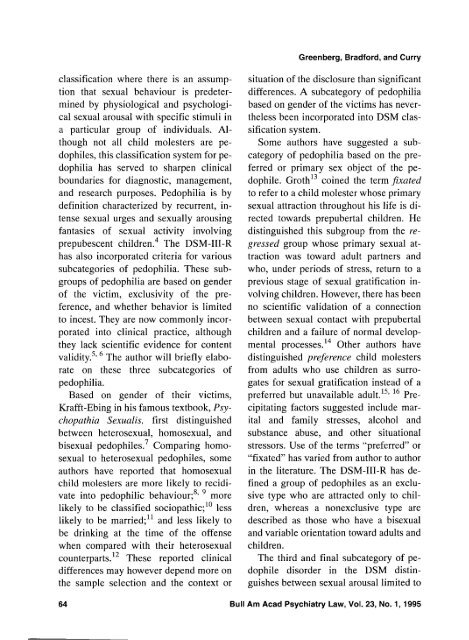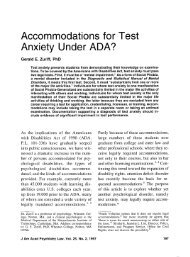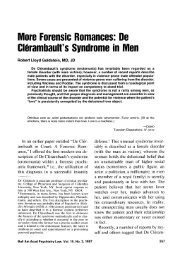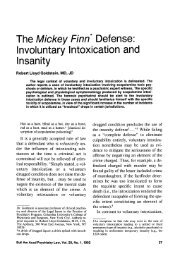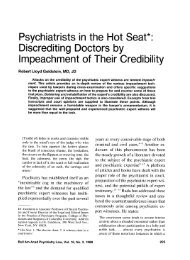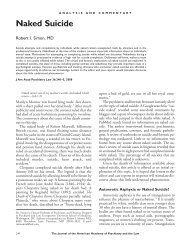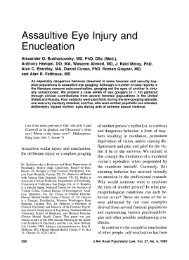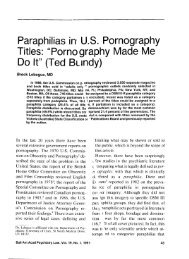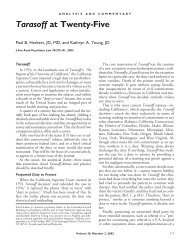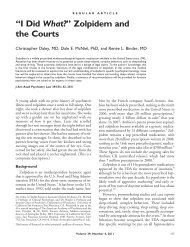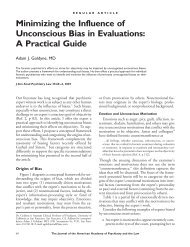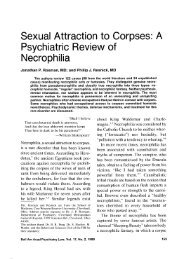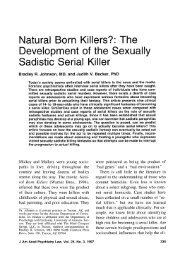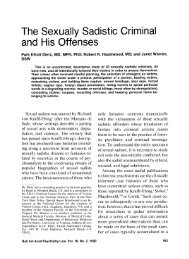Infantophilia-A New Subcategory of Pedophilia?: A Preliminary Study
Infantophilia-A New Subcategory of Pedophilia?: A Preliminary Study
Infantophilia-A New Subcategory of Pedophilia?: A Preliminary Study
You also want an ePaper? Increase the reach of your titles
YUMPU automatically turns print PDFs into web optimized ePapers that Google loves.
classification where there is an assumption<br />
that sexual behaviour is predetermined<br />
by physiological and psychological<br />
sexual arousal with specific stimuli in<br />
a particular group <strong>of</strong> individuals. Although<br />
not all child molesters are pedophiles,<br />
this classification system for pedophilia<br />
has served to sharpen clinical<br />
boundaries for diagnostic, management,<br />
and research purposes. <strong>Pedophilia</strong> is by<br />
definition characterized by recurrent, intense<br />
sexual urges and sexually arousing<br />
fantasies <strong>of</strong> sexual activity involving<br />
prepubescent ~hildren.~ The DSM-111-R<br />
has also incorporated criteria for various<br />
subcategories <strong>of</strong> pedophilia. These subgroups<br />
<strong>of</strong> pedophilia are based on gender<br />
<strong>of</strong> the victim, exclusivity <strong>of</strong> the preference,<br />
and whether behavior is limited<br />
to incest. They are now commonly incorporated<br />
into clinical practice, although<br />
they lack scientific evidence for content<br />
validity.5' The author will briefly elaborate<br />
on these three subcategories <strong>of</strong><br />
pedophilia.<br />
Based on gender <strong>of</strong> their victims,<br />
Krafft-Ebing in his famous textbook, Psychopathia<br />
Sexualis, first distinguished<br />
between heterosexual, homosexual, and<br />
bisexual pedophiles.7 Comparing homosexual<br />
to heterosexual pedophiles, some<br />
authors have reported that homosexual<br />
child molesters are more likely to recidivate<br />
into pedophilic beha~iour;~, more<br />
likely to be classified sociopathic;10 less<br />
likely to be married;" and less likely to<br />
be drinking at the time <strong>of</strong> the <strong>of</strong>fense<br />
when compared with their heterosexual<br />
counterparts.12 These reported clinical<br />
differences may however depend more on<br />
the sample selection and the context or<br />
Greenberg, Bradford, and Curry<br />
situation <strong>of</strong> the disclosure than significant<br />
differences. A subcategory <strong>of</strong> pedophilia<br />
based on gender <strong>of</strong> the victims has nevertheless<br />
been incorporated into DSM classification<br />
system.<br />
Some authors have suggested a subcategory<br />
<strong>of</strong> pedophilia based on the preferred<br />
or primary sex object <strong>of</strong> the pedophile.<br />
~roth'~ coined the term fixated<br />
to refer to a child molester whose primary<br />
sexual attraction throughout his life is directed<br />
towards prepubertal children. He<br />
distinguished this subgroup from the regressed<br />
group whose primary sexual attraction<br />
was toward adult partners and<br />
who, under periods <strong>of</strong> stress, return to a<br />
previous stage <strong>of</strong> sexual gratification involving<br />
children. However, there has been<br />
no scientific validation <strong>of</strong> a connection<br />
between sexual contact with prepubertal<br />
children and a failure <strong>of</strong> normal developmental<br />
processes.14 Other authors have<br />
distinguished preference child molesters<br />
from adults who use children as surrogates<br />
for sexual gratification instead <strong>of</strong> a<br />
preferred but unavailable adult. 15, 16 precipitating<br />
factors suggested include marital<br />
and family stresses, alcohol and<br />
substance abuse, and other situational<br />
stressors. Use <strong>of</strong> the terms "preferred" or<br />
"fixated" has varied from author to author<br />
in the literature. The DSM-111-R has defined<br />
a group <strong>of</strong> pedophiles as an exclusive<br />
type who are attracted only to children,<br />
whereas a nonexclusive type are<br />
described as those who have a bisexual<br />
and variable orientation toward adults and<br />
children.<br />
The third and final subcategory <strong>of</strong> pedophile<br />
disorder in the DSM distinguishes<br />
between sexual arousal limited to<br />
64 Bull Am Acad Psychiatry Law, Vol. 23, No. 1, 1995


